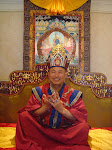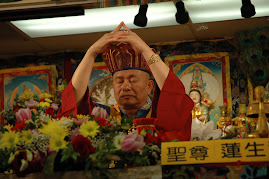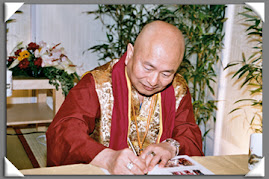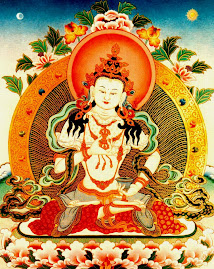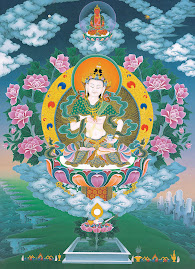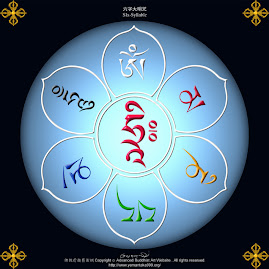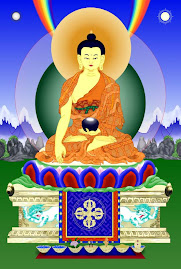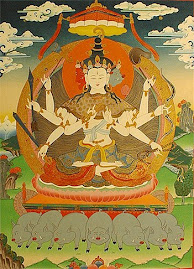Introductory Note: Fu talismans are powerful esoteric cures originating from Taoism. Many Chinese Feng Shui masters will be aware of Fu talismans and some are even able to create them. This way many things that could not ordinarily be changed in a Feng Shui consultation can be quickly transformed. For example, one's mental states, the energy within a home, black magic and mischeif caused by Yin spirits can all be very quickly remedied by the use of Fu talismans. The use of such charms is as old as Feng Shui itself.
Good afternoon, ladies and gentlemen.
In the mini soul deliverance ritual just concluded, many souls have appeared - including those of cats and dogs. Obviously someone must have registered on their behalf. In fact, all the sentient beings from the six realms of existence have shown their presence in the ceremony.
There will be a fun fare tomorrow. Today I want to talk about "Fu protective charm" or talismans, since so many of you have come from overseas.
A disciple wrote to me and asked whether the protective charm that he has carried with him for years is still effective. He wanted to know whether the charm will still protect him as his job involves a lot of travelling, as a result the charm is often soaked with perspiration. He wondered whether his body odour will drive the Buddhas/Bodhisattvas away. I feel the urge to answer his questions right now.
How long will a protective charm last after being empowered? Is there a validity period? Some say it must be re-empowered once a month, while others says once a year. Many people lose their confidence in the protective charm as they are uncertain about how long the empowerment will last. Some disciples complained that they still fell down while walking, had minor accidents when they were not at home, they wonder whether protective charm is really effective. That is why I want to talk about protective charm today.
Whether the protective charm is effective depends on our frame of mind. We must have confidence in it and seem to have confidence in it. For instance, I hang a crossed Vajra in my car, and every morning before I drive the car, I will cup my palms and pay respect to it by reciting a certain mantra. How do we pay respect to the protective charm that we wear? All we need to do is to take it out and touch our brow-point respectfully once a day and wear it again. Before we sleep, bath, or go to toilet, we can take it off. If we want to wear it again, we must hold it to touch our brow-point first. Using our forehead to touch the protective charm is a form of showing respect to the Buddha. And cupping our hands is another. The protective charm will never lose its power; hence it is not necessary for it to be re-empowered.
Whenever we see protective symbols such as the Mahakala hanging on the door, or the charms inside people's house, we must cup our palms to show our respect to them. Likewise, we must respect others' sacred shrines. This is an indication that "when there is a will, there is a Buddha." We will experience spiritual response, and be protected. As long as we respect the protective charm, it is not necessary to do a great prostration to it , or make offering to it. The protective charm that we wear must be placed at a clean place if taken out. When we want to wear it again, we use it to touch our forehead. This is to show respect to the god of the protective charm. If we do it everyday, he will protect us. As regards mantra, we can use "Om Mani Padme Hum" (pronounced
In Tantrayana Buddhism, there is a Dharma known as "Chu Ji-Tuo". In which a person will use his head to touch the Buddha's foot. By paying respect to Buddha this way, one will be protected by the Buddha if he steps on your head. Using protective charm to touch our forehead is also one of the "Chu Ji-Tuo". I hope all of you can understand me now. In short, if we want the protective charm to be effective, we want Buddhas to empower us daily, we must respect the protective charm. This is the right way we should treat our protective charm.
============================================================
History of The Talismans
This was written by yellow dragon
How Talismans Work
The history of Chinese Taoist talismans stretches back over 5000 years into the mists of time. The symbols that cover the talisman contain the secrets of the Universe.
Although they were conceived thousands of years ago they are based on sound scientific principles of the creative and destructive processes of the
universe and the psychological makeup of the human race. The symbols are pictorial representations, e.g. one stroke equals one heaven; one dot equals one universe.
To explain how Talismans work, we must first explore the theories and concepts behind them:
When the first caveman drew the first stick figure on a cave wall, he was using a symbol. He was using a symbol to represent part of his world. Ever since then, Man has used symbols not only to illustrate concepts, but to manipulate his reality. Because our world is constantly changing, we have used words and names to record what has happened. Every name is a symbol; your name written down symbolises you. Where and when your name is written has an effect on your life and reality.
Everything on Earth is just like a symbol, for example the Tai Chi sign represents the whole Universe; One straight line represents Yang, the male energy of the Universe, and a Broken line represents Yin the female energy of the Universe.
For instance the Pa Qua represents the 8 Directions, different people, parts of your body, elements, seasons, natural phenomenon (like Fire, wind, Earth, Forests, Sun, Moon, lake, thunder, Earth etc.), family relationships etc, it also represents change and non-change.
The talisman uses the whole universal form, transformed into a symbol and changes the way things are.
The Application of Talisman in Feng Shui
Original writer (Chinese Text): Mrs. Jia Yin Smith of San Francisco, California (
In ancient times, Talismans or Fu Zhou (magic figures or incantations) were objects for matching up. A bamboo board was typically broken into two pieces which were used for corroboration. Talisman or Fu Zhou originated during the period of the Three Kings and the Five Emperors. The first king was Fu Xi who observed the sky and surveyed the geographical features from the tracks of birds and animals and also invented Ba Gua, using Ba Gua to form the language in the talismans. These ancient talismans reflected how people use Ba Gua to make predictions in those days and these symbols were compiled to form the Book of Change or Yi Jing( I Ching). Talismans were associated with an Emperor by the name of Xuan Yuan or Huang Di.
The mechanism of talismans or Fu Zhou are not based on the material used but on maneuvering the Chi. When writing symbols on the talisman, one is actually matching the Chi of the universe and using the strength of the reflecting stars. When I was in primary school, I had a classmate who suffered from a parotid gland infection named boar head skin disease by the common people. A stamp inscribed with the Chinese character tiger was dipped in blue-black ink and was used to stamp the infected area of the patient. Two weeks later the patient recovered. Isn that incredible? The Tiger character is supposed to be able to eat the boar, metaphorically. The ancient Chinese physicians used talismans to cure sickness. This branch of knowledge is called the discipline of Zhu You section. When writing talismans, one is supposed to chant holy words. These talismans can be consumed by burning the paper and drinking the ashes with water. Alternatively, one can just keep the talismans for protection to bring good fortune and to ward off evil spirits as well as people with evil intentions.
Traditionally, feng shui masters have used talismans to help ward off bad luck or Sha. For example, when a house is directly facing the road, the master would place a stone inscribed with. Tai Shan stone dares to resist (the evil influences) in front of the house. Incidentally, Tai Shan is China most celebrated mountain range and it is believed that the stone from this mountain range has the ability to fend off Sha (noxious vapors) and Kuei (various kinds of demons). Houses that are facing temples and shrines are considered bad because it is believed that evil spirits normally gather outside the temple. Placing a piece of stone inscribed with Yu Qing (literally translation means pure jade which has the ability to fend off evil spirits) is an extension of the application of talisman.
The Yang Chai Ten Book states to renovate a house and to relocate a door if one does not have resources, this could not be done. Even if one has resources, one still needs to select an auspicious day and time. If the omen of the house is bad and one could not wait for the appropriate day and time, one can use talismans to protect the house for peace and security. In terms of function, there are two kinds of talisman: The first one is direction talisman and the other one is time talisman. Examples of direction talisman are: (1) stone dares to resist (the evil influences), (2) mountain and water protection, (3) tai ji symbol, (4) ba gua talisman and (5) wording talisman. These talismans are normally placed in inauspicious locations of the house, for instance the main door or walkway or bridge leading to the main door, the corner of the house, the position directly facing the roof-top and places in front or at the back of the house which are considered to have bad feng shui.
When performing renovation on a day that happens to be inauspicious according to the Chinese almanac, then time talisman could be used. Feng shui masters can use holy words and symbols to write talisman to change the bad omen into good luck.
Using talisman in feng shui, removes the psychological barrier and deals with the taboos of the culture. With the application of talisman, the feng shui master can stay away from an awkward predicament where there are no other feng shui cures.
Note: There were many versions concerning the name of the three Kings. Some regarded Fu Xi, Zhu Rong, and Shen Nong as the three Kings. Some textbook mentioned Sui Ren, Fu Xi, and Shen Nong. Some people considered Fu Xi,
The five emperors refer to Huang Di, ZhuanXu, Di Ku,Di Yao,Di Shun. Huang Di was born 5000 year ago during the New Stone Age. His family name is Gongsun and he is being called Xuan Yuan.









